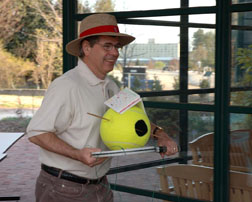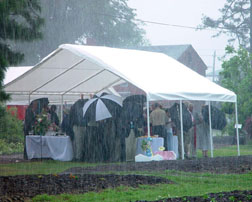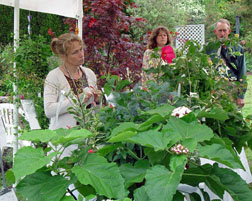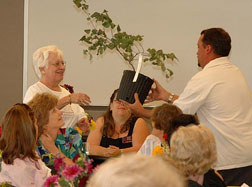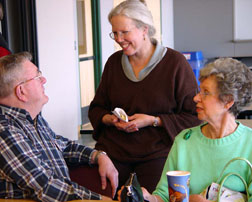Friends
of the Arboretum Newsletter
Volume 8,
Number 2
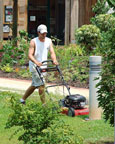 |
 |
 |
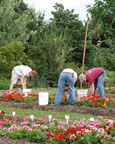 |
Director's Letter
Mid-Year Reflections
By Bob Lyons, Ph.D., Director
It is frequently said that the plant collections are our most valuable asset here at the JC Raulston Arboretum, but I often contend that our human resources merit the highest value. That being said, our staff has seen lots of flux in the past few months. We said good-bye to Heather Chapman, who has taken another position within the University. Heather came as a temporary worker but learned our system quickly; she was subsequently hired as a permanent employee and managed our main telephone number along with countless other duties. She mastered her job with ease and we were very sad to see her go. Another farewell went to Anne Calta, who started with us several years ago, first as a student assistant and later working her way up to permanent, full-time status. If ever there were a person who experienced virtually all that the JCRA had to offer, it would be Anne. Among her many responsibilities, she cared for collections, propagated plants, and most recently managed our nursery operations and pulled together our Friends plant distribution program in the fall. She has made a move to Boone, North Carolina with her good friend Patrick Pitzer, and they both will be forging new dimensions within their careers.....we wish Anne and Patrick the very best.....get out those snow shovels and snow shoes, guys, you'll be missed! Peter Conden was hired shortly after Anne's departure to make sure we stayed on track. He has been nothing short of a lifesaver, assuming an octopus-like posture, working in our nursery and just about any other facet of our operations. Peter completed his M.S. in our department and truly loves all things "plants." He will hold this position temporarily until we can re-advertise and make a permanent hire. It is appropriate to note that funding for this position comes directly and entirely from you, and it has become critical to our overall operations. Finally, I can't leave the subject of staff without reference to our newest student interns, all privately funded. Your generosity was especially key this year as we welcomed, in no particular order, Heather Barkley (Jack Lamm Intern), Judy Morgan-Davis (Sudden Impact Intern), Jeff Jones (Ben Anderson Intern), Jeremy Rogers (North Carolina Commercial Flower Growers' Association Intern), Derek Washburn (North Carolina Association of Nurserymen/Alan MacIntyre Intern), and James Lail (Raleigh Garden Club/Friends of the JCRA Intern).....and don't let me forget Mark Blevins who continued into the summer as a paid student assistant. We already have two full time internships sponsored for 2005 so please give me a call if you wish to add your name to this list; we would love to top this year's success! It will be the most gratifying investment you'll ever make!
Gala Expenses |
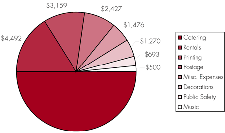 |
Gala Income |
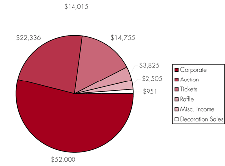 |
Onto the Gala.........aside from the looming skies and eventual tornado warning, a good time was had by all! I think the evacuation down to the Ruby C. McSwain Education Center and the absolute soaking we all got will be most memorable. The good news was that the event was a grand financial success thanks to the leading efforts of Donna Walker, the CALS Advancement team, her committee, and corps of staff and volunteers. All told, there was a net of about $68,000.00! This was later distributed as $20,000.00 going to future development efforts, $10,000.00 to our overall JCRA Endowment, and $38,000.00 to General Operations. The latter fuels just about everything we do......from hiring student assistants, paying for supplies and equipment, acquiring new plants and updating collections, general grounds maintenance, to just about any surprise that comes our way. More details can be gleaned from the charts in this issue and it is noteworthy that in addition to a near record gross income, our expenses were also down from last year! Kudos to all.
We very much appreciate the new working environment provided by the JCRA buildings. The challenge now becomes one of making the buildings "work" for us and our visitors. We've been concentrating lately on integrating two key functions in the McSwain Education Center: maintaining a personal presence at the reception desk and establishing a consistent staffing schedule in our bookstore/gift shop. Our volunteer coordinator, Frankie Fanelli, has worked with the volunteers to staff the front desk for most of the week. They assist our receptionist Faye Koonce and the many visitors who drop in. The McSwain Education Center has brought new visibility to the JCRA and a recent, nonscientific poll suggested that the majority of our visitors were first timers looking for an enjoyable place to spend some time. The Bookstore and Gift Shop, however, has proven to be more challenging and we're indebted to the volunteers who have staffed the store to date.....we continue to make refinements in this area and look forward to when this store will be fully patronized for its fine collection of eclectic garden and plant books and becomes a significant source of new revenues for the JCRA. We have consistent staffing on Mondays, Thursdays, and Fridays from 10:00 AM-2:00 PM, but you can always call Faye at (919) 513-7457 for any updated hours.
After a year of observing the new implications of room reservations in the McSwain Education Center, we launched our own use and fee guidelines for the York Auditorium and select areas within the JCRA and, yes.....weddings are possible again! Faye Koonce is our point person for these events and can fill you in on all the necessary details, so please give her a call at (919) 513-7457 if you are interested in scheduling your group. The guidelines were initially developed via an internal committee led by Board member Ann Armstrong, who deserves tremendous credit for their origination, development, and follow-through with her committee members. In fact, now that we've used these guidelines for several months, we're ready to revise them based on our experiences to date. Life is more complicated than before when fees only applied to weddings in the Klein-Pringle White Garden, but these fee-based reservations have great potential to create an important revenue stream for the JCRA, so we'll guide their evolution. The York Auditorium is fast becoming a popular meeting venue for both small and large groups, and its notoriety is primarily driven by word of mouth and networking. My advice: plan in advance; short notice reservations are harder to get these days!
Last year we introduced our very first Annual Appeal through the creativity and guidance of our Development staff headed up by Anne Porter. It was a great success, once again proving the strength of our supporters. All told, $13,845.00 was raised through this effort, and after we did the math, we learned that the appeal did not detract from historical giving that we see near year's end. Here's an idea of how those appeal funds were used: approximately $6,500.00 was earmarked for paid student assistants during the 2004-2005 academic year. It is always gratifying to bring in students to work alongside our staff, so this fund easily proved its value! Another $2,300.00 was targeted our computer systems. For any manager these days, computers will propel you to the top and at the same time be the root of all evil! Frustrations kick-in when they crash, need upgrades, require new software, or simply need to be replaced. The remainder of the monies was directly funneled into general operations.....I've said this before, having a secure "general" account lets me sleep easier!
The past months have seen plenty of activity in three long term projects led by staff. The Doggett Family Kiosk is currently under development and internally spearheaded by staff member Val Tyson. This has been an extended process in design and content development, but we are excited about the potential of the finished product.....which may very well be in place by the time you read this newsletter! Nancy Doubrava has been leading the efforts to complete a federal grant awarded by the Museum Assessment Program (MAP) of the Institute of Museum and Library Services. She has diligently guided internal surveys, public perception data collection, and analysis to arrive at a better picture of how we are perceived. The grant will culminate in the visit by two other directors of similar institutions, who will provide a follow up document of impressions and recommendations for us. And the third project of long-term and large-scale proportions is the development of our statewide evaluation network, headed up by Todd Lasseigne with assistance from Jon Roethling. Both have worked tirelessly this past spring to get our first set of plants installed in sites from the mountains to the coast. Most sites are partnerships with outlying NCSU Research and Extension Centers who help evaluate plants we've targeted for landscape potential. With all 12 sites installed, our first checks have begun this summer and we're excited about the potential information we'll derive from the program.
The JCRA continues to rack up the accolades. Most recently, the Perennial Plant Association awarded the JCRA Perennial Border a 2004 Landscape Design Award of Merit, no small feat in the context of this national competition. We were officially presented the award at the national PPA meeting in July in "The City" (New York City for those of us raised in that area, Manhattan to be even more specific!) Our printed materials also achieved national recognition in 2004. The pairing of our new brochure and informational "rack card" received first place recognition from the National Agricultural Alumni and Development Association at their 2004 national convention. These pieces are exquisite and represent the cooperative efforts of staff leaders Nancy Doubrava and Chris Glenn, who worked with designer Shari Sasser. Finally, two very notable JCRA oaks received "Champion" status in the Capital Trees Program of Wake County. Our Oglethorpe oak (Quercus oglethorpensis) and columnar English oak (Quercus robur f. fastigiata) now join company with our Japanese crepe myrtle (Lagerstroemia fauriei 'Fantasy') as "Champions" of importance and size in their class in our home county, Wake.
I'd like to close on a poignant note and recognize the loss of two friends of the JCRA this year. Please read Anne Porter's section in this newsletter, but I'd like to add a few words of my own. First, we lost an ardent supporter with the passing of Willie York. I recall meeting Willie for the first time when first interviewing for this directorship over five years ago. He was genuinely interested in what I could bring to the Arboretum, how that would fit, and hearing my ideas for seeing the McSwain Education Center campaign to closure. I visited him in his office where he enjoyed reminiscing about Raleigh in general, discussing his late wife Lib's interest in the JCRA, and his love for roses. To say that he was pivotal in our advancement would be an understatement; for it was not his financial generosity alone that made a difference, it was also his infectious ability to tell others about the treasure over here in west Raleigh. We are exceptionally fortunate to have many members of the York family continue their support to this day, including his daughter Phyllis Brookshire, who currently sits on our Board of Advisors. The JCRA is also indebted to the family for remembering us following the loss of Willie.....thank you. Another individual who will be missed is Julia Skinner, one of the original Friends of the Arboretum members. I often saw her at our lectures, escorted by her good friends and fellow aficionados of both plants and opera, Bobby Ward and Roy Dicks. Julia left a generous, planned gift to the JCRA, and I had marvelous conversations with Bobby and Roy regarding her dual passions and the ways we might remember her. I remain so appreciative to folks who remember the JCRA in the ways of the Yorks and Julia Skinner; their thoughtfulness is so important!
I hope you continue to see the great things we are doing here and the progress we're making; don't ever hesitate to enlist the interest of others; members are our lifeblood....and don't forget to visit in person or via our Web site!
Survey Update
Thank You for Your Valuable Comments
By Nancy Doubrava, Interpretive Specialist
Do you remember the survey that arrived in your mailbox late last winter from the JC Raulston Arboretum? We certainly do, and want to thank everyone for their comments and suggestions. We were simply bowled over with valuable feedback from our members and delighted to have a response rate of over thirty five percent. Thank you for taking your time to complete this survey; all of your suggestions are greatly appreciated and we received many excellent ideas.
This Community Questionnaire Survey is a part of a larger self-study process currently underway at the Arboretum, developed to help us improve the way we serve the community and all of our audiences. Funded by a federal grant from Institute of Museum and Library Services (IMLS), the Museum Assessment Program is helping us to assess our strengths and weaknesses and plot a course for future improvements in the area of the public dimension.
This winter, an on-site review is scheduled to take place by two museum professionals who have been selected for their expertise with botanical gardens and arboreta. They will review our on-site efforts, self-study workbook results, and prepare a report of recommendations for change. Implementation of these recommendations at the JCRA will be the final and certainly the most challenging phase of the program.
Horticulture
Amazing Amaranths
By Judy Morgan-Davis, Sudden Impact Intern
What do tumbleweed, summer poinsettia, and pigweed have in common with a federally threatened species and an ancient Aztec food staple? They are all members of the genus Amaranthus, a fascinatingly diverse group of plants that certainly deserves attention.
Amaranths are herbaceous annuals with inconspicuous flowers, but long-lasting, colorful bracts. The name Amaranthus, in fact, refers to the "unfading" nature of its showy inflorescences. At least 60 species of amaranths are native to the tropical regions of the world, and many taxa have naturalized in more temperate climates. From a physiological standpoint, amaranths are interesting because they utilize a photosynthetic pathway that enables the plants to minimize water loss in extremely hot, dry conditions and generally to tolerate stressful environments. Close relatives of the amaranths include Celosia (cockscomb), Gomphrena (globe amaranth), and Alternanthera (calico plant).
 The
familiar image of tumbleweed balls blowing across the main street of a western
movie set is usually Salsola tragus, a near relative of the amaranths.
But don't feel misled by this article's opening tease - Amaranthus albus is an amaranth that shares the common name "tumbleweed" because, like
the western icon, it is uprooted by the wind after its leaves drop in the fall.
Because of their adaptive mobility, both plants have become troublesome weeds,
especially in agricultural and horticultural settings.
The
familiar image of tumbleweed balls blowing across the main street of a western
movie set is usually Salsola tragus, a near relative of the amaranths.
But don't feel misled by this article's opening tease - Amaranthus albus is an amaranth that shares the common name "tumbleweed" because, like
the western icon, it is uprooted by the wind after its leaves drop in the fall.
Because of their adaptive mobility, both plants have become troublesome weeds,
especially in agricultural and horticultural settings.
Speaking of weeds, most gardeners and farmers can quickly recognize the red roots of the pigweed (A. retroflexus), so called because of pigs' fondness for foraging its leaves. Unfortunately, the leaves can accumulate nitrates, which in large doses are toxic to pigs and other livestock; however, toxicity is typically not a problem when neither drought nor supplemental fertilizing is excessive. Even when pigweed is not ingested, this amaranth is unwelcome in the field or garden because of its aggressive competition with cultivated plants. Since each inflorescence produces thousands of seeds, it is important to eliminate this prolific weed before it sets seed.
Despite the bad reputation that pigweed has earned around the world, other species of this genus are not only attractive; they are useful and valuable as well. On a recent edition of "The Splendid Table," a program that airs on National Public Radio, host Lynne Rossetto Kasper identified a caller's mystery green as "red amaranth" (probably A. tricolor 'Calaloo'), a "stunningly beautiful" vegetable worthy of the centerpiece as well as the dinner plate. She suggested stir-frying the leaves and stems of amaranth with garlic and ginger, comparing the flavor of these greens to spinach, but with a "meatier edge" than its taxonomically close relative.
The palatability of amaranth is not a new discovery. For over 5,000 years Amaranthus species have been cultivated as food, and even revered, by cultures around the world. In addition to pinching the tender greens, the small seeds are harvested and utilized as a grain. Once dried, the seeds are popped or milled to yield rich, nutty-tasting flour. Both the leaves and seeds contain high levels of calcium and iron. The seeds also have higher protein content than traditional cereals, with an especially high percentage of the amino acid lysine.
In addition to providing nutrition, amaranth flour was used by the Aztecs in religious rituals and the grains were (and still are) fermented to produce an alcoholic beverage. Some evidence suggests that this civilization also may have interplanted amaranth with other crops to repel insect pests. Another theory is that the amaranth actually was planted to attract insects, which provided still another tasty source of protein.
On a more esoteric level, the Greeks, who gave the plant its name, associated the unfading amaranth with immortality and decorated tombs with its image. In modern times, practitioners of flower essence therapy invoke the essence of amaranth to treat clients who experience difficulty relaxing and letting go. There is more to these plants than meets the eye, although many taxa provide quite an eyeful.
The aesthetic value of the amaranths is found in their drama: extravagant inflorescences, outrageous foliage, or, at least, really graphic names. Amaranthus caudatus, commonly known as "love-lies-bleeding," produces long tail-like inflorescences that range in color from red to purple to green. The cultivar 'Velvet Curtains' also offers color-coordinated purplish foliage. A seemingly conservative member of the genus, A. cruentus derives its specific epithet from the "bloodstained" color of its flowers. A. hypochondriacus also has an interesting name which refers to the somber, depressive colors of the dramatically upright inflorescence. Typically grown for its bright, multicolored foliage, A. tricolor resembles the showy bracts of poinsettia, hence its common name "summer poinsettia."
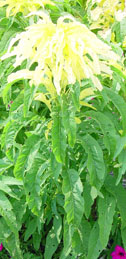
 This summer at the JCRA, the annuals display includes the following ornamental Amaranthus taxa: A. caudatus, A. caudatus 'Ponytails', A. caudatus 'Velvet
Curtains', A. caudatus 'Viridis', A. cruentus 'Hot Biscuits', A. hypochondriacus 'Magic
Fountains', A. tricolor 'Aurora', A. tricolor 'Illumination', and A. tricolor 'Perfecta'. Most
visitors noticed the screaming colors of 'Perfecta' and 'Illumination', but
the subtle, earthy tones of 'Magic Fountains' were also admired. 'Viridis,' the
green-flowered cultivar of A. caudatus, offered interesting textural effect
without shocking color contrast.
This summer at the JCRA, the annuals display includes the following ornamental Amaranthus taxa: A. caudatus, A. caudatus 'Ponytails', A. caudatus 'Velvet
Curtains', A. caudatus 'Viridis', A. cruentus 'Hot Biscuits', A. hypochondriacus 'Magic
Fountains', A. tricolor 'Aurora', A. tricolor 'Illumination', and A. tricolor 'Perfecta'. Most
visitors noticed the screaming colors of 'Perfecta' and 'Illumination', but
the subtle, earthy tones of 'Magic Fountains' were also admired. 'Viridis,' the
green-flowered cultivar of A. caudatus, offered interesting textural effect
without shocking color contrast.
One last species of amaranth must be mentioned: Amaranthus pumilus, the seabeach amaranth. This species has been listed as federally threatened since 1993 due to habitat loss; however, research and restoration projects are currently underway, including sites on the North Carolina coast. A North Carolina State University botany student, Kristen Rosenfeld, has conducted her graduate studies of this plant at Bird Island in Brunswick County. According to Kristen, preservation of seabeach amaranth is important not only for ecological reasons, but also for the potential genetic contribution of a plant that can tolerate almost constant salt spray and drought conditions.
The genus Amaranthus is a versatile group of plants that has been useful to humans for thousands of years. So the next time you notice an unwelcome pigweed seedling in the garden or a garish roadside display, take time to appreciate its grounding essence and its sophisticated metabolism, or...make a salad.
Where Can I Find This Plant?
By F. Todd Lasseigne, Ph.D., Assistant Director
Every week, I receive an assortment of e-mails asking the ever-familiar question to all gardeners, "Where can I find plant X?" Try as I might to help out, although I cannot ever answer all of these queries, I sometimes can recommend a nursery of some sort or another that meets the request at hand. Although J. C. Raulston made regular efforts to publish lists of mail-order nurseries, this has not been done over the past several years. What follows here is an attempt to highlight selected nurseries and some of the more outstanding plants that have come across my path through their catalogs and Web sites.
Ordering plants through the mail, especially so in the modern day of the Internet and "Google" searches, affords a greater selection of plants available to gardeners than through any other vehicle. Even the most well-stocked of garden centers simply cannot offer the tremendous diversity of trees, shrubs, vines, herbaceous perennials, and tender perennials that can be found in mail-order nursery catalogs.
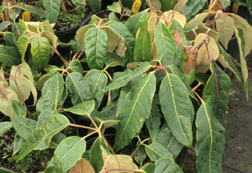 One
such catalog is that of Fairweather Gardens (Greenwich, NJ). Known as a nursery
that always produces beautiful catalogs stocked with rich horticultural treasures,
this year's edition greeted me with a stunning cover mélange of the wonderful
foliage of Forsythia koreana 'Kumson', the gold-vein Korean forsythia.
Yet, even more thrilling beauties awaited me inside the pages. One that immediately
caught my attention was Digitalis obscura, obscure indeed, and a gem
of an evergreen (yes, evergreen), perennial foxglove. Boasting bright orange
flowers on 12-18" upright spikes, this plant was a favorite of mine to
show to Arboretum visitors in 2003 when our specimen in front of the Lath House
would not stop flowering from late spring to late summer. Equally thrilling
to see was the availability of Lycoris ×haywardii, the electric
surprise-lily. This summer-flowering bulb produces flowers in colors (bright
pink, suffused at the tips of the petals with rich, bright blue pigments) that
one would typically associate only with tropical plants; yet, it is hardy, easily,
in Raleigh. Then, I noticed the listing of several cultivars of the ever-popular Cornus mas (Cornelian cherry), these cultivars new to the West, introduced
from Russia. However, for me, the arrival of the Fairweather Gardens catalog
signaled only one thing - my chance to see Schefflera delavayi offered
for sale in U.S. commerce. Yes, a hardy Schefflera - not just your
father's houseplant any more! The heart skips a beat just with the thought
of such a plant existing. You can thank, as we have, Bob Hoffman and Bob Popham, for finding and offering these plants, and
also for donating many of them to the JCRA over the years.
One
such catalog is that of Fairweather Gardens (Greenwich, NJ). Known as a nursery
that always produces beautiful catalogs stocked with rich horticultural treasures,
this year's edition greeted me with a stunning cover mélange of the wonderful
foliage of Forsythia koreana 'Kumson', the gold-vein Korean forsythia.
Yet, even more thrilling beauties awaited me inside the pages. One that immediately
caught my attention was Digitalis obscura, obscure indeed, and a gem
of an evergreen (yes, evergreen), perennial foxglove. Boasting bright orange
flowers on 12-18" upright spikes, this plant was a favorite of mine to
show to Arboretum visitors in 2003 when our specimen in front of the Lath House
would not stop flowering from late spring to late summer. Equally thrilling
to see was the availability of Lycoris ×haywardii, the electric
surprise-lily. This summer-flowering bulb produces flowers in colors (bright
pink, suffused at the tips of the petals with rich, bright blue pigments) that
one would typically associate only with tropical plants; yet, it is hardy, easily,
in Raleigh. Then, I noticed the listing of several cultivars of the ever-popular Cornus mas (Cornelian cherry), these cultivars new to the West, introduced
from Russia. However, for me, the arrival of the Fairweather Gardens catalog
signaled only one thing - my chance to see Schefflera delavayi offered
for sale in U.S. commerce. Yes, a hardy Schefflera - not just your
father's houseplant any more! The heart skips a beat just with the thought
of such a plant existing. You can thank, as we have, Bob Hoffman and Bob Popham, for finding and offering these plants, and
also for donating many of them to the JCRA over the years.
To me, a relative newcomer on the scene was Klehm's Song Sparrow Perennial Farm, a mail-order nursery hailing out of Avalon, Wisconsin. Even King Arthur himself could not have picked a better selection of plants, for this catalog literally oozed with amazing new offerings - too many to discuss in this mere article. Of all the plants listed, I would consider Cornus alternifolia 'W. Stackman' (Golden ShadowsT, PP 11,287) to be a horticultural equivalent of the Holy Grail. This stunning new cultivar of our eastern U.S. native pagoda dogwood bears bright, gold-edged leaves, all set on the classically arranged, tier-like branches. Definitely a tree worth seeking out. Song Sparrow also listed two other choice rarities: Corylopsis spicata 'Golden Spring' (PP 13,821), a new winterhazel hailing from Japan and bearing both golden-yellow flowers and, later in the year, equally stunning golden foliage; and Metasequoia glyptostroboides 'Jack Frost', a new dawn redwood that bears attractive, white-tipped new growth. We thank both Roy Klehm and John Elsley for being so generous in donating many of their listed plants for us to grow and evaluate here at the JCRA.
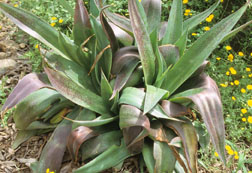 Yucca
Do Nursery Inc. (Hempstead, TX) continues to locate and produce wondrous gems
of the plant kingdom, many from far-flung destinations. Their 2004 Web listings
saw the naming and "worldwide exclusive" offering of Pinus taeda 'JC Raulston'. This dwarf loblolly pine originated from graftwood collected
in the late 1980s by J. C. himself from what he deemed to be the best of the
dwarf loblolly pines growing in the Arboretum. This graftwood found its way
to Doremus Wholesale Nursery (Warren, TX) and thence to Yucca Do. One of these
beautiful grafted pines (donated by our friends Mark Bronstad and Ted Doremus at Doremus Wholesale Nursery) was auctioned
at our 2004 Gala in the Garden. In 2004, Yucca Do also introduced the horticultural
world to the "mangave" (pronounced "man GAH vee"), a plant
that possibly originated as a naturally occurring intergeneric (yes, intergeneric)
hybrid between Manfreda variegata and Agave celsii; or it
may be simply a tetraploid form of Manfreda variegata. Dubbed 'Macho
Mocha', this plant bears nearly surreal, thick, fleshy leaves, richly spotted
lurid brown-purple. You'll either amaze or scare your neighbors with this plant.
Discovered on a roadside in Argentina in 2003, Yucca Do now offers the truly
amazing Nierembergia gracilis 'Starry Eyes'. This perennial cup-flower,
unlike other more commonly grown species, thrives in our summer heat and humidity,
and flowers virtually nonstop from April through October. The open-faced, pale
purple and white flowers are held, almost as if floating, above an ethereal
mass of wiry green stems and tiny leaves. In the bulb world, Yucca Do has begun
to offer named clones from their nigh-famous "Labuffarosea" strain
of Zephyranthes (rain lilies). Currently, they list Zephyranthes 'Lily Pies', but we also obtained Zephyranthes 'Stars', these representing
broad-petaled and narrow-petaled clones, respectively, of the Labuffarosea seed
strain. Wonders never cease from our friends - Carl Schoenfeld and Wade Roitsch - at Yucca Do Nursery.
Yucca
Do Nursery Inc. (Hempstead, TX) continues to locate and produce wondrous gems
of the plant kingdom, many from far-flung destinations. Their 2004 Web listings
saw the naming and "worldwide exclusive" offering of Pinus taeda 'JC Raulston'. This dwarf loblolly pine originated from graftwood collected
in the late 1980s by J. C. himself from what he deemed to be the best of the
dwarf loblolly pines growing in the Arboretum. This graftwood found its way
to Doremus Wholesale Nursery (Warren, TX) and thence to Yucca Do. One of these
beautiful grafted pines (donated by our friends Mark Bronstad and Ted Doremus at Doremus Wholesale Nursery) was auctioned
at our 2004 Gala in the Garden. In 2004, Yucca Do also introduced the horticultural
world to the "mangave" (pronounced "man GAH vee"), a plant
that possibly originated as a naturally occurring intergeneric (yes, intergeneric)
hybrid between Manfreda variegata and Agave celsii; or it
may be simply a tetraploid form of Manfreda variegata. Dubbed 'Macho
Mocha', this plant bears nearly surreal, thick, fleshy leaves, richly spotted
lurid brown-purple. You'll either amaze or scare your neighbors with this plant.
Discovered on a roadside in Argentina in 2003, Yucca Do now offers the truly
amazing Nierembergia gracilis 'Starry Eyes'. This perennial cup-flower,
unlike other more commonly grown species, thrives in our summer heat and humidity,
and flowers virtually nonstop from April through October. The open-faced, pale
purple and white flowers are held, almost as if floating, above an ethereal
mass of wiry green stems and tiny leaves. In the bulb world, Yucca Do has begun
to offer named clones from their nigh-famous "Labuffarosea" strain
of Zephyranthes (rain lilies). Currently, they list Zephyranthes 'Lily Pies', but we also obtained Zephyranthes 'Stars', these representing
broad-petaled and narrow-petaled clones, respectively, of the Labuffarosea seed
strain. Wonders never cease from our friends - Carl Schoenfeld and Wade Roitsch - at Yucca Do Nursery.
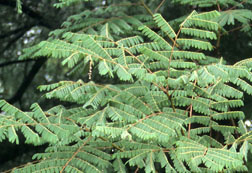 Coming
our way from even farther west - Williams, Oregon to be precise, - was the semiannual
tome that is Forestfarm Plant Nursery's catalog. Always overflowing with goodies,
one is usually dumbfounded as to which plants to choose as well as from the
voluminous amount of knowledge contained inside each volume. (Thanks to Ray and Peg Prag for continuing to produce such excellent catalogs
over the years.) Among the standouts for us this year were the following:
A) Gymnocladus chinensis, Chinese coffeetree, a deciduous tree of exquisite
texture and form, appearing almost tropical by the unique arrangement of its
many small leaflets; B) Magnolia ×kewensis 'Wada's Memory'
- consistently, one of the best magnolias in our collection, owing to its multi-season
interest and large, white flowers, but still difficult to locate in commerce;
C) Tilia henryana - Henry's linden - a Chinese native linden that we
acquired 3½ years ago and that in Raleigh has already proven its garden worth,
with its attractive, textural leaves, emerging pink-bronze in spring; D) Berberis
temolaica - blue barberry - a deciduous shrub with the most powdery blue
leaves that you will see on any broadleaf plant; and E) Convolvulus cneorum - silverbush morningglory - a tight, mounding, evergreen shrub (yes, evergreen,
and yes, shrub) with silver leaves that virtually glitter in sunlight, and funnel-shaped,
white flowers typical of morningglories. These are only five plants out of
the many choices available to you from Forestfarm.
Coming
our way from even farther west - Williams, Oregon to be precise, - was the semiannual
tome that is Forestfarm Plant Nursery's catalog. Always overflowing with goodies,
one is usually dumbfounded as to which plants to choose as well as from the
voluminous amount of knowledge contained inside each volume. (Thanks to Ray and Peg Prag for continuing to produce such excellent catalogs
over the years.) Among the standouts for us this year were the following:
A) Gymnocladus chinensis, Chinese coffeetree, a deciduous tree of exquisite
texture and form, appearing almost tropical by the unique arrangement of its
many small leaflets; B) Magnolia ×kewensis 'Wada's Memory'
- consistently, one of the best magnolias in our collection, owing to its multi-season
interest and large, white flowers, but still difficult to locate in commerce;
C) Tilia henryana - Henry's linden - a Chinese native linden that we
acquired 3½ years ago and that in Raleigh has already proven its garden worth,
with its attractive, textural leaves, emerging pink-bronze in spring; D) Berberis
temolaica - blue barberry - a deciduous shrub with the most powdery blue
leaves that you will see on any broadleaf plant; and E) Convolvulus cneorum - silverbush morningglory - a tight, mounding, evergreen shrub (yes, evergreen,
and yes, shrub) with silver leaves that virtually glitter in sunlight, and funnel-shaped,
white flowers typical of morningglories. These are only five plants out of
the many choices available to you from Forestfarm.
Back on the east side of the continent, and only about 30 miles west of the Arboretum is one of the great mail-order nurseries of North Carolina - Camellia Forest Nursery, owned by our friend, David Parks. Specializing in camellias as their name suggests, this Chapel Hill nursery continually stocks a diverse array of non-camellioid trees and shrubs, too. Ones that have been exciting to see listed for sale include: A) Craibiodendron yunnanense - a close relative of Pieris, with pink-bronze new growth and white, bell-shaped flowers borne in large, paniculate inflorescences; B) Pseudolarix amabilis - golden larch - a deciduous tree that we have long admired here at the Arboretum for its soft- and fine-textured appearance and golden autumn tints, surprisingly still not easily found; C) Metasequoia glyptostroboides 'Ogon' - golden dawn redwood - a gold-foliaged deciduous conifer of tightly pyramidal form, maintaining foliage color throughout the growing season; and D) Taxodium distichum 'Cascade Falls' - weeping bald cypress - an outstanding variation on our native bald cypress, this cultivar originating at Cedar Lodge Nursery (New Plymouth, New Zealand) several years ago, but only now becoming available in commerce in the U.S. Of course, however, a trip to Camellia Forest Nursery would be incomplete without considering at least one camellia, and probably the best I saw in 2003 was Camellia sasanqua 'Seventh Desire', one of several new weeping camellias. With the typical dark, black-green, glossy foliage of the sasanquas, combined with double, bright pink flowers in autumn, you might think that you have enough to work with from this plant. However, add to that a unique weeping growth habit, and 'Seventh Desire' becomes one of those must-have camellias.
Again, crossing the U.S. to the Pacific Northwest, we come to Collector's Nursery (Battle Ground, WA), owned by Diana Reeck and Bill Janssen. I first became aware of Collector's Nursery in 2002, observing their catalog and then visiting the nursery during the summer months while on a tour of Pacific Northwest nurseries and gardens. With the plethora of nurseries in the Northwest, one would think that at some point they would all be growing the same plants, since there just cannot be enough different plants to go around and fill all of these nurseries' catalogs, eh? Well...let's just say that you would be wrong to think that way. This year's Collector's Nursery catalog saw the release of several quite exciting plants. Although developed at the wholesale nursery of famed Oregon plantsman Talon Buchholz (Buchholz and Buchholz Nursery, Gaston, OR), the "Ghost" series Japanese maples had not previously been advertised in mail-order circles. From Collector's, we were able to buy Acer palmatum 'First Ghost', 'Grandma Ghost', 'Purple Ghost', and 'Sister Ghost'. These new cultivars of Japanese maple bear leaves wherein the veins and margins are thinly traced in green, and the remaining portions of the leaf are either colored white or reddish-purple. These are very different Japanese maples when one first sees them - definitely not just another purple-leaf Acer palmatum! Beyond these maples, however, it was also exciting to see the following three variegated plants: A) Philadelphus lewisii 'Mount Tahoma' - a newly found white-splashed variegate of this Northwestern native mock-orange, this cultivar also bearing double flowers; B) Camellia japonica 'Taimo' - one of several true variegated camellias (not virus-induced variegation) just starting to enter commerce, 'Taimo' bears glossy, dark green leaves that are striped yellow-gold in the center of each blade; and C) Daphne ×transatlantica 'Summer Ice' - a deciduous shrub with somewhat narrow, gray-green leaves, edged in white, originating as a sport from Daphne ×transatlantica 'Jim's Pride' selected by Robert Ticknor, Ph.D., now retired from the North Willamette Research and Extension Center in Aurora, Oregon. Daphne ×transatlantica 'Jim's Pride' is a name now given to the North American clone of an evergreen shrub long known, grown, and labeled as Daphne caucasica, but which was later discovered to be a hybrid between that species and Daphne collina. (An old specimen labeled "Daphne caucasica" - 'Jim's Pride' in actuality - has long grown at the Sarah P. Duke Gardens in Durham, North Carolina.) Grow 'Summer Ice' for its spicy-sweet white flowers (backed pink), as well as the white-margined foliage. And last, but not least, in true "Collector's" Nursery fashion, was probably the most desirable of all the plants seen - Edgeworthia chrysantha 'Red Dragon' - the red-flowered golden paperbush. As Edgeworthia chrysantha is now justly receiving acceptance in the consumer marketplace, as many plantsfolks have long extolled its virtues, there have been whisperings of the "red form" existing in Japan. Well, those rumors were true! Bearing orange-red flowers in pendent umbellate clusters, 'Red Dragon' and other red forms of this species are sure also to gain widespread appeal in time. Get yours now from Collector's Nursery and be ahead of the gardening curve!
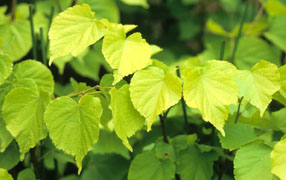 In
beginning to wind up this article now, it seems only appropriate that I should
go to Horticulture's Mecca - Heronswood Nursery of Kingston, Washington. Conjured
into existence by Dan Hinkley and Robert Jones,
J. C. once commented on this nursery as "the plant kingdom for sale."
Indeed! As I received my copy of their 2004 catalog - a veritable florilegium
- I poured through the pages to see what treasures lurked in those pages. Ranging
from the clichéd (but not clichéd in this case) "Abelia to Ziziphus,"
Heronswood's offerings are always astounding and humbling. Two taxa and two
groups of taxa caught my eye this time, in particular. Tilia cordata 'Akira Gold', a gold-leaf littleleaf linden, immediately brought up memories
of my travels in Japan and in meeting Akira Shibamachi, nurseryman
and Japan's leading plantsman. Discovering this beautiful gold- to chartreuse-leaf
form of littleleaf linden, I witnessed this plant in 2001 in Japan but was unaware
of it being resident in any U.S. nursery. Upon seeing the plant at Heronswood,
I knew that the Arboretum needed to have a specimen. A second plant, Deutzia
setchuenensis var. corymbiflora (Sichuan deutzia), exemplifies
the long relationship that exists between the Arboretum and Heronswood, for
Dan writes in the 2004 catalog, "This (deutzia) was given to us by J. C.
Raulston many years ago, and we are thankful we can now share it with other
gardeners across N(orth) America." With almost a baby's-breath-like appearance
to the inflorescences, this white-flowered deutzia truly looks like no other
deutzia that is seen in U.S. gardens. It is deserving of widespread cultivation.
In
beginning to wind up this article now, it seems only appropriate that I should
go to Horticulture's Mecca - Heronswood Nursery of Kingston, Washington. Conjured
into existence by Dan Hinkley and Robert Jones,
J. C. once commented on this nursery as "the plant kingdom for sale."
Indeed! As I received my copy of their 2004 catalog - a veritable florilegium
- I poured through the pages to see what treasures lurked in those pages. Ranging
from the clichéd (but not clichéd in this case) "Abelia to Ziziphus,"
Heronswood's offerings are always astounding and humbling. Two taxa and two
groups of taxa caught my eye this time, in particular. Tilia cordata 'Akira Gold', a gold-leaf littleleaf linden, immediately brought up memories
of my travels in Japan and in meeting Akira Shibamachi, nurseryman
and Japan's leading plantsman. Discovering this beautiful gold- to chartreuse-leaf
form of littleleaf linden, I witnessed this plant in 2001 in Japan but was unaware
of it being resident in any U.S. nursery. Upon seeing the plant at Heronswood,
I knew that the Arboretum needed to have a specimen. A second plant, Deutzia
setchuenensis var. corymbiflora (Sichuan deutzia), exemplifies
the long relationship that exists between the Arboretum and Heronswood, for
Dan writes in the 2004 catalog, "This (deutzia) was given to us by J. C.
Raulston many years ago, and we are thankful we can now share it with other
gardeners across N(orth) America." With almost a baby's-breath-like appearance
to the inflorescences, this white-flowered deutzia truly looks like no other
deutzia that is seen in U.S. gardens. It is deserving of widespread cultivation.
Regarding now the two groups of plants that I was compelled to study upon receiving my catalog, these are Hydrangea (but not those that are normally encountered) and Metapanax. What, you say, could we learn that is not already known about Hydrangea? Much! Just two plants from their list of over 65 different kinds of hydrangeas can bring about a better understanding of the future of this genus: Hydrangea angustipetala, a deciduous shrub with narrow, lanceolate leaves and white flowers borne in lace-cap formation, versus Hydrangea integrifolia, an evergreen vine with lustrous, dark green foliage and large terminal clusters of small white flowers. Add to this the undoubted future sales of Hydrangea indochinensis, a purportedly evergreen, shrubby species from northern Vietnam, and you know that Heronswood continues to be the place to watch for the latest and greatest in Hydrangea.
On Metapanax, a group of evergreen shrubs related to Fatsia and other araliads, little to nothing is known about them in the U.S. For a few years now, the Sarah P. Duke Gardens has grown Metapanax davidii (formerly called Nothopanax davidii) and Metapanax delavayi (formerly called Nothopanax delavayi), both of which have suffered no injury at temperatures below 0°F. Collections made in China of Metapanax - some not yet identified to species - by Dan and others from Heronswood Nursery show an extraordinary range in leaf shape, lobing, color, gloss, and other characteristics. This, assuredly, will be an exciting genus of plants to watch, and at the least will expand the realm of successfully growing "Fatsia-like" plants in the southeastern U.S. Dan and Robert, especially, but also all the Heronistas at Heronswood Nursery have been extraordinarily generous in sharing with the Arboretum so many of these newfound treasures awaiting gardening discovery throughout the U.S. All gardeners and nurseries, alike, will benefit from Heronswood's mission, spirit, and offerings.
Next time we visit this subject, I'd like to feature more mail-order nurseries - Woodlanders Inc., Gossler Farms Nursery, Almost Eden, and Plant Delights Nursery, Inc. - as well as some North Carolina and nearby wholesale growers. Stay tuned!
Development
Gala in the Garden 2004
By Donna Walker, Development Associate
 There's
a quotation about the "best laid plans of mice and men." Add "Gala
Committees" to that. After months of planning and hard work, May 2, 2004
arrived and Mother Nature decided to be uncooperative. After several years
of great weather and the current need for rain, we couldn't complain too much,
but driving rain, big gusts of wind, and a tornado warning was a bit much.
To the guests who decided to brave the weather, you were the greatest! Umbrellas
and raincoats were the accessories of the day and I saw several people just
give up and remove their shoes. Everyone seemed to enjoy the day in spite of
the deluge.
There's
a quotation about the "best laid plans of mice and men." Add "Gala
Committees" to that. After months of planning and hard work, May 2, 2004
arrived and Mother Nature decided to be uncooperative. After several years
of great weather and the current need for rain, we couldn't complain too much,
but driving rain, big gusts of wind, and a tornado warning was a bit much.
To the guests who decided to brave the weather, you were the greatest! Umbrellas
and raincoats were the accessories of the day and I saw several people just
give up and remove their shoes. Everyone seemed to enjoy the day in spite of
the deluge.
I want to express my heartfelt thanks to the wonderful committee who worked so
hard to put together a great event and to the corporate sponsors who gave so
generously. This year's Gala was one of the best - and was certainly profitable. We
will put just over $68,000.00 into the JCRA coffers and for this we thank everyone
who participated. The committee and corporate sponsors are listed below. Please
add your thanks to ours if you should speak with any of these JCRA supporters. I
also send my thanks to Wallace and Jeanette Hyde who were Honorary
Chairs and Tom and Nancy Bland, Event Chairs. And a special thanks
to Steve Walker and Tim Hinton, who were "Command Central" for
the event, and to Bill and Libby Wilder, who did an outstanding
job preparing the invitations.
The date for next year's Gala is Sunday, May 1, 2005. Please mark your calendar
and plan to be with us.
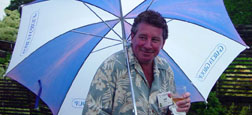 Gala
in the Garden Corporate Sponsors
Gala
in the Garden Corporate Sponsors
Diamond Sponsor
North Carolina Association of Nurserymen
Platinum Sponsor
A. E. Finley Foundation, Inc.
Gold Sponsors
Jeanette & Wallace Hyde
Van Wingerden International
Silver Sponsors
Jane & Bob Avinger
Bland Landscaping/Tom & Nancy Bland
CALS College Advancement
Campbell Road Nursery
Carroll's Plant Center
Century Framing/Bobby Wilder
Helen & Leo Daughtry
Dover Foundation
The Hamlin Companies
Hawksridge Farms, Inc.
Horticultural Asset Management, Inc.
Department of Horticultural Science, NCSU
Little & Little
Murphy Family Farms
Pender Nursery/Jim Deal
Quality Staffing
Taylor's Nursery
Bronze Sponsors
The Brickman Group, Ltd.
Phyllis & Donnie Brookshire
Coca Cola Bottling Company Consolidated
Encore Azalea®
Fair Products
Tom Gilmore
Golden Corral
GoldKist/Ralph & Sue Upton
Hefner's Nursery
Melda & Bill Lamm
Rick & Linda Lawson
Lichtin Family Foundation
Tommy & Marsha Massey
Christopher McLachlan
Myatt Landscaping Concepts, Inc.
North Carolina Farm Bureau Federation
Pennington Seeds Virginia Division
Piedmont Carolina Nursery
Sampson Nursery
Southern Landscaping Professionals/Panther Creek
Sparrow Construction Co./Ray & Melba
Sparrow
United Energy/Haddon & Irma Clark
Wakefield Nursery
Wyatt-Quarles Seed Company
Rosemary & Smedes York
Other
The JWY Batchelors
Gala in the Garden Committee
Jill Chouinard Adams
Kara Bertoncino
Tom & Nancy Bland
Irma Clark
Rosemary Easton
Phyllis Eller-Moffett
Marty Finkel
Judi Grainger
Faye Koonce
Anita Kuehne
Pat Long
Bob Lyons
Brad & Shelley McCain
Linda Murphy
Marge O'Keeffe
Joan Petty
Anne Porter
Sylvia Redwine
Wren Rehm
Jon Roethling
Amy Veatch & Miles Wright
Donna Walker
Janice Weedon
Ed Willer
Jan Wilson
Gallery C Event
By Donna Walker, Development Associate
The staff at Gallery C and Henry Isaacs once again joined with the JCRA for an artists' reception, held at their art gallery in the Quail Ridge Shopping Center here in Raleigh. The evening was spent talking with Henry, Charleen Harless, and Adam Cave, Gallery C owner and director, respectively, and the many guests who came to admire Henry's work and to support the JCRA. Each attendee enjoyed meandering the gallery while sipping a glass of wine and munching delicious hors d'oeuvres. They also received a beautiful gicleè as a memento of the evening.
Henry is so talented and we're honored that he frequently visits the JCRA for inspiration. In his remarks, Henry reminded us that he must travel many hundreds of miles to visit the JCRA and, as we're all so much closer, we should take advantage of the beauties and peacefulness offered in the JCRA gardens. Our thanks to the Gallery C folks and to all those who shared the evening with us.
Connoisseur Plants Program
By Donna Walker, Development Associate
Just a reminder about our Connoisseur Plants Program. Connoisseur plants are rare new plants or hard to find old favorites, and they are part of the membership benefits for members at the following levels:
Sponsor ($250.00) - 2 Connoisseur Plants
Patron ($500.00) - 5 Connoisseur Plants
Benefactor ($2,500.00) - 10 Connoisseur
Plants
Philanthropist ($5,000.00) - 15 Connoisseur Plants
If you've already joined at a lower level and would like to receive these wonderful plants, merely send in a check to raise your previous membership level to the higher level. To be eligible for the 2004 year, your donation must be received by November 30, 2004. Contact Donna at (919) 513-3826 or at <donna_walker@ncsu.edu> for more information.
Planting the Seeds for Development
By Anne M. Porter, Director of Development
Special Friends - Gone, But Not Forgotten
The JC Raulston Arboretum, family, and friends lost two very special people this spring, Julia Skinner and J.W. "Willie" York. Both of these remarkable individuals were unique in their passion and support of the JCRA.
Julia Wood Skinner
We lost this special friend on May 24, 2004. Julia was born in Elizabeth City, North Carolina, but she lived most of her life in Raleigh. She graduated from the University of North Carolina at Chapel Hill where she was a member of Pi Beta Phi Sorority and Phi Beta Kappa. She was an ardent devotee of opera, and she traveled to most parts of the world, usually to see opera but also to visit natural areas, such as Peru's Macchu Picchu and the Amazon.
Julia's love of gardening was equal to her love of opera. She was a long-term member of the Piedmont Chapter of the North American Rock Garden Society (NARGS) and regularly attended the meetings. She was one of the initial members (November 1980) of the Friends of the North Carolina State University Arboretum (now the JC Raulston Arboretum) and came faithfully to the lecture series, always eager to see if she had won a plant in the drawings. She looked forward to each year's Connoisseur Plant list and regularly attended the fall plant giveaways, bringing along her little red wagon to gather up the goodies. Julia never learned to drive, so she depended on friends to get her to the NARGS and Arboretum events. She remained active to the end, attending her final Friends of the Arboretum Lecture just last December (Frank Cabot).
In 1996, Julia created a charitable gift annuity to benefit the JC Raulston Arboretum and the College of Humanities and Social Sciences (CHASS) at NC State University. Through her foresight and this generous planned gift, the JCRA will have funds for many important programs and functions. There will be a special lecture named in her memory, a full-time sponsored intern for summer 2005, the front reception desk in the Ruby C. McSwain Education Center named in her honor, a gift to benefit the JCRA Endowment for Excellence, and much more.
What a tremendous impact this planned gift will make for the JC Raulston Arboretum!
 James
Wesley "Willie" York
James
Wesley "Willie" York
We lost this special friend on March 2, 2004. Willie York shaped this community through his dedicated leadership, volunteerism, and philanthropy. Through his tremendous vision, he created and developed Raleigh's Cameron Village more than fifty years ago.
Willie was an ardent supporter of the JC Raulston Arboretum. In 1995, the York's funded The Necessary (the much-needed public restrooms) located in the Arboretum's eastern gardens. Additionally, he encouraged government officials to pass legislation to appropriate funds for an educational building at the Arboretum. In a bold action, he made a $300,000.00 challenge during the 1999 Gala in the Garden, and his pledge was fulfilled in January 2001. Of course, in September 2002, we dedicated the Ruby C. McSwain Education Center. Today, visitors, JCRA members, faculty, and students enjoy the York Auditorium that Willie and his children dedicated to his late wife, Lib York.
In 1996 and in 1999, Lib and Willie York served as Honorary Chairs for the annual fund-raising event, Gala in the Garden. His daughter, Phyllis York Brookshire, was the 2002 Gala Chair, and she currently serves on the Arboretum's Board of Advisors. His son and daughter-in-law, Smedes and Rosemary York, were the 2003 Honorary Chairs for the Gala in the Garden. Willie's family carries on this tradition of leadership and support.
The community has shown their deep appreciation, love, and friendship for Willie through the more than $11,000.00 that the Arboretum has received in memorial gifts. Among other things, these gifts will be used to name a special lecture in his memory, a full-time sponsored intern for summer 2005, and a gift to enhance the JCRA Endowment for Excellence.
Additionally, four of Willie's dear friends, Bill Burns, Tim Clancy, Dick Daugherty, and Hal Hopfenberg, (aka "The Bachelors") paid special tribute to their friend through a sponsored pocket garden in memory of Willie.
Memorial and Tribute Gifts
What better way to remember or honor a loved one, friend, business, or organization than with a special memorial tribute gift? There are many opportunities - from an engraved brick, to a garden bench, or a named garden. Your gift to sponsor a garden is used to directly support the JCRA. This is a gift that will keep on giving - to the many people who visit the Arboretum and to the special loved one(s) you choose to honor!
Bequests & Planned Gifts
Just as our dear friend, Julia Skinner made a special planned gift, you have the opportunity to specify a gift by writing your will or living trust to include the JC Raulston Arboretum as a beneficiary. A planned gift is an incredible opportunity to capture tax-saving benefits now and leave a rich legacy for the future.
Additional Ways to Give Beyond Membership Support
Outright Gifts
Includes cash, appreciated property (stock, real estate) or tangible personal property. A special thanks to all the generous friends of the Arboretum who continue to give during the 2004 Annual Appeal!
Matching Gifts
Many gifts from active or retired employees qualify for matching gifts from their employers. Please check with your employer - this could double your gift!
Real Estate or Securities Gifts
Donors pay no capital gains on the increased value with their gift of stock or other appreciated real estate.
Gifts of Insurance
You may specify the JC Raulston Arboretum as beneficiary of an existing policy, or you may make a pledge by purchasing a new whole life insurance policy and naming the JCRA as the recipient.
For more information on these giving opportunities, please call or e-mail Anne Porte at (919)513-3463 or <anne_porter@ncsu.edu>.
Programs
Friends of the Arboretum Lecture
"Show and Tell"
You are the Guest Speaker
September 16, 2004 (Thursday) - 7:30 PM
Free for members - $5.00 for nonmembers
York Auditorium, Ruby C. McSwain Education Center, JCRA
Don't miss this unique FOA Lecture in which the audience is the expert! Do
you have some photographs of your home garden or favorite plants that you would
like to share? Then don't miss this unique opportunity for members and the
general public to exchange their gardening experiences. Are you new to the
Triangle? Then this lecture is also for you. Come and see what others are
growing.
Audience participation is a must. If you are interested in participating, submit your digital photographs, slides, and photographs by September 14, 2004 (Tuesday) to Chris Glenn. Contact Chris at (919) 513-7005 or <chris_glenn@ncsu.edu> for submission guidelines. Slides and photographs will be scanned and all images will be added to an electronic slide show prior to the lecture. Each individual's photographs will be grouped and will be presented by their owner. Plan to spend up to five minutes per presenter.
Plantsmen's Tour - Free
"Shade Trees"
Todd Lasseigne, Ph.D., JCRA Assistant Director
September 24, 2004 (Friday) - 1:00 PM
Begins at entrance to the Ruby C. McSwain Education Center, JCRA
Ahhh, after a hard day's work, there's nothing better than enjoying the cool,
refreshing shade underneath your favorite tree. Come and join Todd on a tour
featuring some of the JCRA's brightest stars (both new and old) as potential
shade trees for our gardens and urban landscapes. There's more to shade trees
than red maple (Acer rubrum), after all!
Friends of the Arboretum Lecture
"A Eulogy for Color? I'm Not Ready to Gas Up the Hearse"
Bob Lyons, Ph.D., Director
October 1, 2004 (Friday) - 7:30 PM
Free for members - $5.00 for nonmembers
York Auditorium, Ruby C. McSwain Education Center, JCRA
Color has been a dominant gardening force in the past decade, especially with
the infusion of tropical, tender plant materials into the landscape color
palette. With the pipeline still flush with new and underutilized plants
that fit this "brilliance scheme," it is hard to believe that we
don't have many more years ahead of us to integrate them into garden designs. This
talk will not only illustrate the current practices of bold color use but
also help dispel any rumors of its impending demise.
Annual Plant Distribution
October 2, 2003 (Saturday) - 9:00 AM (it's
over at 9:05 AM)
Registration begins at 7:30 AM at the entrance to Ruby C. McSwain Education
Center, JCRA
Free for members - nonmembers must become members
Take home as many free
plants as you can grab in the few minutes before they are gone. This annual event is our most popular program because we give away
thousands of plants, many of which are rare and unusual. Do not forget to
bring a cart to carry all of your new plants. Memberships will be sold the
morning of the giveaway.
Pi Alpha Xi Annual Plant Sale
October 16, 2004 (Saturday) - 8:00 AM-4:00 PM
October 17, 2004 (Sunday) - 10:00
AM-3:00PM
Offering rare and unique annual, perennial, and woody ornamentals. Proceeds
benefit horticultural scholarships and area nonprofit organizations. For more
information, contact a Pi Alpha Xi member at (919) 515-3178 or visit <www.ncsu.edu/project/pialphaxi/>.
JC Raulston Arboretum Symposium
"From Origins to the Landscape"
October 22, 2004 (Friday) - 6:00
PM-9:30 PM
October 23, 2004 (Saturday) - 8:00 AM-4:30 PM
York Auditorium, Ruby C. McSwain Education Center, JCRA
$125.00
for members - $155.00 for nonmembers
Symposium information packets are being
mailed to the Arboretum's members. For
additional details or questions, please visit the Arboretum's Web site or contact
Chris Glenn at <chris_glenn@ncsu.edu> or (919) 513-7005. To register,
please call Faye Koonce at (919) 513-7457.
Plantsmen's Tour - Free
"JCRA Behind the Scenes"
Todd Lasseigne, Ph.D., JCRA Assistant Director
October 29, 2004 (Friday) - 1:00 PM
Begins at entrance to the Ruby C. McSwain Education Center, JCRA
From the Engraving Office to the Staff Building, join Todd on a tour of what
happens behind the scenes to make the Arboretum the special place that we
all know it is.
Central Carolina Chrysanthemum Society Show - Free
November 6, 2004 (Saturday) - 12:00 PM-5:00 PM
November 7, 2004 (Sunday) - 12:00 PM-3:00 PM
York Auditorium, Ruby C. McSwain Education Center, JCRA
Join us this fall for the annual Central Carolina Chrysanthemum Society Show. This
beautiful display is free and open to the public. If you are interested in
being a part of the show, please contact the society at (919) 363-5329 or <aambarnhart@nc.rr.com>. They
are accepting entries in the following categories: Division II - Floral Design,
Division III - Baskets, and Division IV - Arts and Crafts (includes photographs,
drawings, paintings, needlework ceramics, etc.).
Friends of the Arboretum Lecture
"Modern Day Plant Explorers"
Bobby J. Ward, Ph.D.
November 18, 2004 (Thursday) - 7:30 PM
Free for members - $5.00 for nonmembers
York Auditorium, Ruby C. McSwain Education Center, JCRA
Get an early peek at Bobby Ward's upcoming book, "The Plant Hunters Garden: The
New Explorers and Their Discoveries." Bobby Ward will share with you
not only who some of the modern day plant explorers are, but even better, their
favorite plants from throughout their years of collecting. He has traveled
to Chile, Canada, UK, Mexico, South Africa, the Czech Republic, and the United
States to interview these modern day explorers and to see where they do their
collecting. Bobby Ward has a degree in plant physiology, received his Ph.D.
in botany from North Carolina State University, and is a retired environmental
scientist and a past-president of the North American Rock Garden Society.
Plantsmen's Tour - Free
"Covering New Ground"
Todd Lasseigne, Ph.D., JCRA Assistant Director
November 19, 2004 (Friday) - 1:00 PM
Begins at entrance to the Ruby C. McSwain Education Center, JCRA
With the common overuse of a limited few groundcovers, join Todd in exploring
a greater diversity of plants suited for use in North Carolina gardens.
Friends of the Arboretum Lecture
Co-hosted by NC State's Office of International Affairs
Plants of China and the Chinese Garden of Washington, D.C.
William Tai, Ph.D.
December 2004
Free for members - $5.00 for nonmembers
York Auditorium, Ruby C. McSwain Education Center, JCRA
We are working with NC State University's Office of International Affairs and
the Chinese community to bring William Tai, Ph.D., to speak about Chinese plants
and the Chinese Garden at the U.S. National Arboretum in Washington, D.C. sometime
during early December. Details have not been formalized, but when they are,
they will be posted on the Arboretum's Web site.
Poinsettia Open House at the JC Raulston Arboretum - Free
December 5, 2004 (Sunday) - 1:00 PM-5:00 PM
York Auditorium, Ruby C. McSwain Education Center, JCRA
NC State Floriculture is part of a national poinsettia program that tests poinsettia
cultivars to determine which ones are best for consumers and for producers. You
will have a chance to see these cultivars yourself and vote for your favorites. Over
110 different cultivars of poinsettias - including new experimental cultivars - will
be on display. Stop by to see our famous 9' tall poinsettia tree and other
displays. Help us decide which poinsettias are North Carolina's favorites.
Plantsmen's Tour - Free
"The Overcrowded Garden"
Todd Lasseigne, Ph.D., JCRA Assistant Director
December 16, 2004 (Thursday) - 1:00 PM
Begins at entrance to the Ruby C. McSwain Education Center, JCRA
As an issue that all gardeners, as well as JCRA Assistant Directors, face,
join Todd in philosophizing on how to manage gardens and plant collections
when space becomes limiting due to over-prosperous plants or overeager garden
plantings.
Plantsmen's Tour - Free
"The Genus Prunus"
Todd Lasseigne, Ph.D., JCRA Assistant Director
January 27, 2005 (Thursday) - 1:00 PM
Begins at entrance to the Ruby C. McSwain Education Center, JCRA
Yes, you really can have year-round interest from just one genus of plants. If
you like apricots, peaches, plums, almonds, cherries (both flowering and edible),
and cherrylaurels, then you're just beginning to understand the importance
and landscape appeal of the Prunus.
Plantsmen's Tour - Free
"A Valentine for Plants"
Todd Lasseigne, Ph.D., JCRA Assistant Director
February 24, 2005 (Thursday) - 1:00 PM
Begins at entrance to the Ruby C. McSwain Education Center, JCRA
If you love plants as we do, then come on over to the JCRA and enjoy the beauties
of Kingdom Plantae.
A Walk in the Winter Garden - Free
February 13, 2005 (Sunday)
1:00 PM - Friends of the Arboretum
Lecture
2:00 PM-4:00 PM - Tours
With all the winter delights at their peak, join us for these exciting guided
tours at the JCRA. Magnificent Japanese flowering apricots, witchhazels,
hellebores, conifers, hollies, winter honeysuckles, and many more plants
will be showcased. Light refreshments will be served. Self-guided tour
brochures will be made available at the Arboretum throughout February.
Triangle Camellia Society Show - Free
March 12, 2005 (Saturday)
York Auditorium, Ruby C. McSwain Education Center, JCRA
Please
contact Lou Bryant at (919) 467-6976 or <mlbryant@mindspringlcom> for
more information.
Volunteering
Volunteer News
By Frankie Fanelli, Volunteer Coordinator
Volunteers participate in every aspect of the JCRA sharing their time, energy and talents! Over 8,000 hours were logged by volunteers in 2003 and already 6,000+ through July 15 for 2004. Rather than tell you what volunteers do let me show you as the following photographs tell it best. This is just a sampling of the JCRA volunteer efforts.
Formatted into HTML by Christopher
Todd Glenn
Programs & Education Coordinator
JC Raulston Arboretum
Department of Horticultural Science
North Carolina State University
Raleigh, NC 27695-7522
© The JC Raulston Arboretum, September 2004


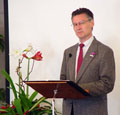
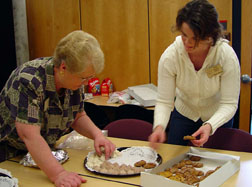
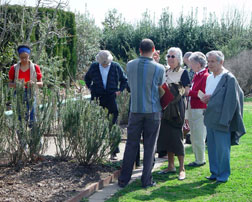
 JCRA
Bookstore and Gift Shop
JCRA
Bookstore and Gift Shop